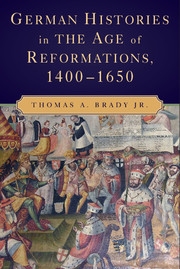Book contents
- Frontmatter
- Contents
- Figures, Maps, and Tables
- Acknowledgments
- A Note on Usages
- Map 1 The Empire in 1547
- Map 2 The Peace of Westphalia, 1648
- Part I The Empire, the German Lands, and Their Peoples
- Part II Reform of the Empire and the Church, 1400–1520
- Part III Church, Reformations, and Empire, 1520–1576
- Part IV Confessions, Empire, and War, 1576–1650
- 13 Forming the Protestant Confessions
- 14 Reforming the Catholic Church
- 15 Limits of Public Life – Jews, Heretics, Witches
- 16 Roads to War
- 17 The Thirty Years War
- 18 German Reformations, German Futures
- Appendix
- Glossary
- Bibliography
- Index
14 - Reforming the Catholic Church
Published online by Cambridge University Press: 05 June 2012
- Frontmatter
- Contents
- Figures, Maps, and Tables
- Acknowledgments
- A Note on Usages
- Map 1 The Empire in 1547
- Map 2 The Peace of Westphalia, 1648
- Part I The Empire, the German Lands, and Their Peoples
- Part II Reform of the Empire and the Church, 1400–1520
- Part III Church, Reformations, and Empire, 1520–1576
- Part IV Confessions, Empire, and War, 1576–1650
- 13 Forming the Protestant Confessions
- 14 Reforming the Catholic Church
- 15 Limits of Public Life – Jews, Heretics, Witches
- 16 Roads to War
- 17 The Thirty Years War
- 18 German Reformations, German Futures
- Appendix
- Glossary
- Bibliography
- Index
Summary
Did, therefore, the faith or the Church perish? [Although] on account of our sins – faith, obedience, and finally the holy sacrifice have been taken away from many cities and territories, they nevertheless remain healthy and unimpaired with others.
Theodor Loher, O. Cart. (1534)If the German Protestant reformers' charges were to be taken at face value, it was highly improbable that the Catholic Church should ever recover, impossible that it should begin to do so within a generation of Luther's death. Yet, just in the 1570s, as Lazarus von Schwendi was ringing the old church's death knell, new life was stirring. By 1600 the Catholic revival was fully underway in the German lands; by 1620 the Protestants lay on the defensive in many places; and by 1630 the Protestant cause seemed defeated by the triumphs of Catholic arms, the emperor's will to restore his church, and the vigor of Catholic evangelization. Divine providence is inscrutable, however, the reason of history cunning, and soon Protestant reformation and Catholic reformation lay locked in a stalemate which would endure for 150 years.
In the Holy Roman Empire the Protestant reformation was a German event, the Catholic reformation was an international event. The term “Catholic reformation” most often refers to the activities of Catholic groups for religious renewal in Italy and Spain during the fifteenth and early sixteenth centuries, later in other countries. A second term, “Catholic counterreformation,” is applied to Catholic defensive measures and efforts to recapture lands lost to the Protestants.
- Type
- Chapter
- Information
- German Histories in the Age of Reformations, 1400–1650 , pp. 291 - 318Publisher: Cambridge University PressPrint publication year: 2009

